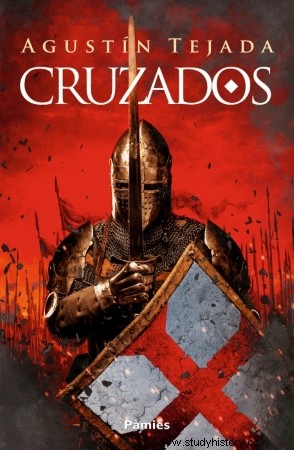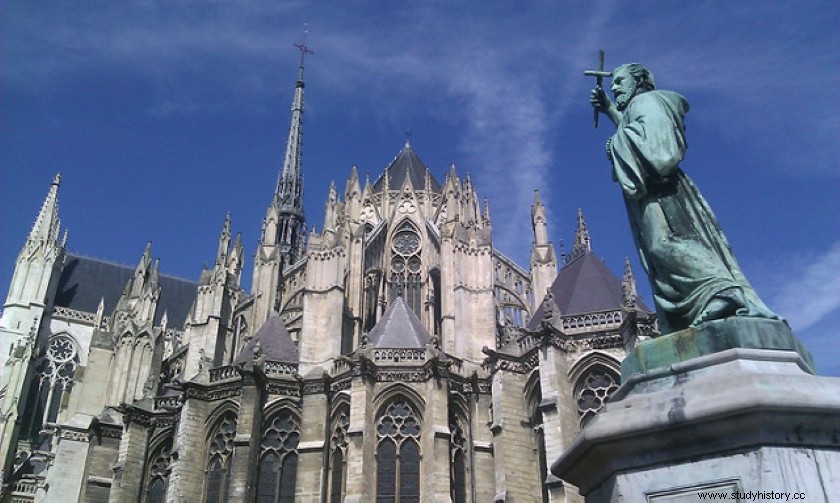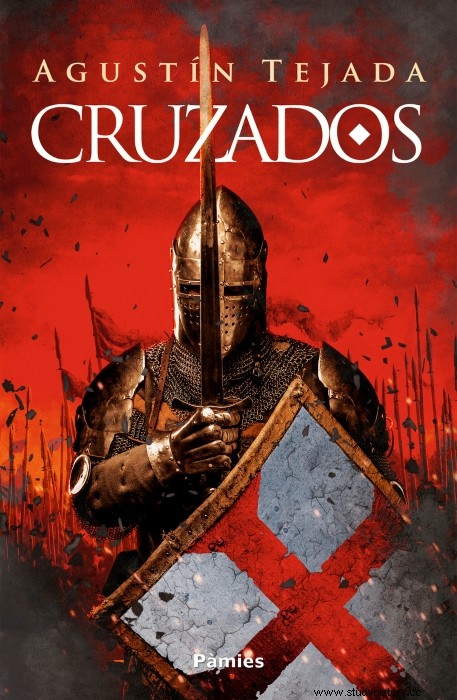
Not long ago, in Walking Through History I We were talking about Urban II's speech that gave rise to the Crusader movement. No matter how many times we want to give it, the crusades were one of the biggest changes in the history of humanity. Two territories united by the Mediterranean, and until relatively a few centuries before under the same political power, the Roman Empire, are preparing to face each other for almost two centuries, under the pretext of surrendering counts to a different God. The followers of Christ, against the followers of Muhammad , two prophets born in the Middle East separated by six centuries of history, will throw the Mediterranean world into its most enormous confrontation.
Although it was clear that the Muslims made the city of Jerusalem their own, the true genesis of this endless war was the product of a new way of being of the Catholic Church. The one that had been dedicated for long centuries of the High Middle Ages to expand to all corners of Western Europe, even reaching the hardest hearts of the pagan Vikings, now converted as Normans into the best warriors of Christ.
But no matter how many territories and hearts she had conquered, she was still subject to political power. You don't have to look far to find the “Investiture Complaint”, a “fraternal” political war between the German emperor and the papacy for the appointment of the main ecclesiastical positions. The Papacy only had one solution left to win this little war, to become a true Papal Monarchy .

Urban II's speech at Clermont
The crusade was the solution, and the call of Alexios I of Constantinople the necessary switch to light the flame. That is why Urban II went to Clermont, and that is why he called the main European nobles to accompany him in the formation of a new power. Across the Mediterranean was a city, Jerusalem, where Christ was born, died and rose, but around it were some of the world's major markets. Now all that remained was to tell those men, largely believers, that it had to be done that way because God had commanded it .
The Poor People's Crusade.
Possibly unintentionally, Urban II also awakened another type of faithful. Those who had nothing to lose, because they had nothing, and therefore had everything to gain. A new world had been promised by the Pope of Rome. All that was missing was a man willing to pick up Urban II's message to send it to the first adventurers. Peter of Amiens , historically known as "Peter the hermit" became the people's prophet. A prophet who, on the back of his donkey, had arrived from Jerusalem with the commission of Christ to recover the holy places.

Pedro «the hermit» in front of the Crusaders of him.
Thousands and thousands of fervent faithful, with shabby clothes and without weapons undertake from Cologne to Constantinople , after Peter of Amiens, the journey of his life. Mainly arriving from areas devastated by long droughts, to a greater extent from north-western France and western Germany. Men who feared nothing, and who made the defense of Christ their own to put an end to all his enemies. The first to verify this were the German Jews, who, under the pretext that they had sold it to the Romans, the expeditionaries fleeced and murdered to obtain the necessary resources for such a "laudable" trip. The worst came at the end, after leaving behind the walls of Constantinople they launched themselves against the powerful army of the Seljuk Turks. Pedro “the hermit” awaits you in the Byzantine capital. Few returned .
Crusaders by Agustín Tejada.
 This is the context chosen by Agustín Tejada to give us his excellent fourth historical novel. There, in that expedition doomed to failure, the Navarrese writer who conquered us with his trilogy on Roman Hispania, introduces five characters born from his fascination with the Middle Ages . Because that, fascination, is what distills each of the 446 pages of this novel, a real gift for our senses.
This is the context chosen by Agustín Tejada to give us his excellent fourth historical novel. There, in that expedition doomed to failure, the Navarrese writer who conquered us with his trilogy on Roman Hispania, introduces five characters born from his fascination with the Middle Ages . Because that, fascination, is what distills each of the 446 pages of this novel, a real gift for our senses.
Novel characters, Crusaders.
Each of the five named characters are chosen by Agustín Tejada to show us the main sociological aspects of the Middle Ages.
Let me start with the most maligned of them. Fray Genaro, commissioned by Bernardo de Séridac, archbishop of Toledo since its Christian conquest in 1085, to provide the new city with the Christian relics necessary for its aggrandizement. Throughout the novel we will have the impression that this was the excuse used to separate him from Toledo. A character that we can accuse of simony, Nicolaism and the rest of the sins that many clerics committed with impunity in the Middle Ages. A vile and ruthless being who becomes the main support of the leaders of the Crusade of the Poor.
With him travels Moraima , a young enslaved Mudejar woman who must personally satisfy Fray Genaro. But a strong and brave woman who will know at all times what she must do to stay alive, in that nonsense of violence that the trip to the Holy Land turned into.
Alonso de Liébana he is the central character of the novel. A young novice whose father decides to introduce him to a religious life, which he neither shares nor understands. If Fray Genaro, the archbishop of Toledo, entrusts him to bring relics of Christ, the young Alonso invites him to a path to know himself. He goes to the Holy Land to save the honor of his family, accused in Toledo of selling horses to Muslims. That was also the excuse, to turn the novice into a soldier of Christ, at the hands of Hervé, the next character.
Hervé he is the quintessential medieval knight. He is without a doubt the best soldier of Christ. If all the members of that reviled crusade had been like Hervé, Jerusalem would have been conquered from day one. A French knight at the service of God and his companions, his mission is to protect everyone's life, to save his own from a dark past.
him I leave for the end the character best achieved by Agustín Tejada. With Hameth the Navarrese writer manages to trap us line after line. If Hervé's past is dark, Hameth's is simply captivating for the reader. A Muslim slave from the monastery of San Servando, who goes to the Christian crusade to serve all the protagonists. A Muslim who says that Mohammed and Christ is just an invention of men to wage war . His purpose was to collect the necessary money to escape from slavery, when the easiest thing would be to escape from that war. He does not do it. The immeasurable motives of him, love and friendship are more important than any of the suffering. A masterful character, who will give us a masterful ending.
The historical characters.
Along with the characters that Agustín Tejada gives us, some of the most important historical figures of the period in question are mixed. Outstanding role for Bernardo de Séridac , the Cluniac monk who Alfonso VI gives him the difficult role of Archbishop, in the recently recovered city of Toledo. Bernardo was present in the first row, thanks to his origin in the Order of Cluny, of the Council of Clermont. Possibly Urban II was looking for an implication of the brave Castilian "reconquerors", although these, already had their particular crusade at the door of his house. A deeply religious, cultured and remarkably intelligent man.

Peter of Amiens in his native town
Many of the members of the Crusade of the Poor are real people. Of course Pedro “the hermit”, a mysterious being that Agustín Tejada does not dare to break down. Ulmer, the leader of the tafures, the most ruthless travelers, is a character who navigates the thin line that separates history from legend. Like Gualterio “the indigent”, who joins the grotesque crusader army after arriving in Constantinople.
When the Crusaders arrived in Constantinople, the second part of the book begins. In it we will meet the most important historical figures of the period. Alejo I the Byzantine emperor, who brought the Empire out of its umpteenth political crisis and who faced the arrival of the Seljuk Turks. The faithful of him General Tatikios , of Turkish origin, a personal friend of the emperor, and the main bridge between the Byzantine and Turkish armies. In front of them Kilij Arslan, the very young Turkish sultan in charge of stopping the arrival of the crusading armies from the west.

Anna Comnena
But the character destined to make history lovers fall in love is Ana Komnenos , the eldest daughter of Alejo I, whom we will see chasing all the protagonists through the splendid Constantinople with her papyri under her arm. One of the first Western historians, and one of the most reliable sources on the arrival of the Crusader armies from Europe to the East.
Let me close this chapter, on royal characters, with two of the greatest medieval knights. Raimundo IV de Tolosa , an almost sixty-year-old who arrives in Constantinople at the head of the true First Crusade, the quintessential crusader knight, a deeply religious man who chooses to die in the Holy Land. Raimundo went to the author of the letter to his friend Rodrigo Ruiz de Vivar , which will trigger the end of the story. A story that, as we see, is a back and forth uniting two of the border cities of the Middle Ages, Toledo and Constantinople. El Cid receives the characters of his novel in Valencia, and the description that Agustín Tejada puts in the mouth of Alonso de Liébana is simply brilliant.
“El Cid Campeador seemed like a tired gladiator to me. Ruy Díaz was of medium height and had broad shoulders, but they were already somewhat sagging. A deep scar ran across his forehead, and he had a slight limp in his right leg. He wore thick but very gray hair, just like his beard. He would have already fought his best battles. But it was true that his eyes gave off that blinding light that can only be seen in the eyes of saints and heroes. ”
Afterword.
As we have seen, Cruzados, by Agustín Tejada, is a journey through the main cities of the Middle Ages. From Toledo, recently recovered by the Christians, to Clermont with Pope Urban II, and even Nicaea to crash against the Turks. Without forgetting, of course, the splendid Constantinople, the most populous city along with Córdoba in the High Middle Ages. But it is also a journey for those who saw the dying Crusade of the Poor pass by. Semlin, Nish or Civetot.
A story of assaults, wars, rapes, murders, cannibalism, looting and endless rampages. But a story where the human being also manages to get the best of himself, courage, friendship, honor and deep love.
Obviously I'm not going to discover the end of Crusaders, it would just be missing. But it is one of the best moments of the novel . Apart from surprising, as a good ending should be, it is magnificently woven by Agustín Tejada. In the last eighty pages it is impossible to stop. It only remains for me to ask the author, if he reads me this review, I am already waiting for a second installment, if it is in your mind, you already have the first reader.

Crusaders in Historioteca
